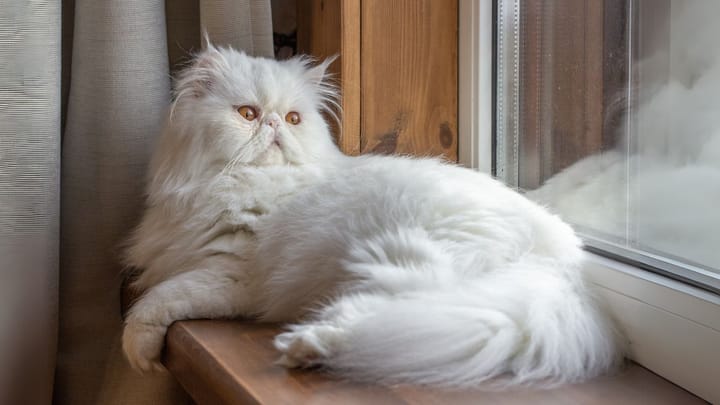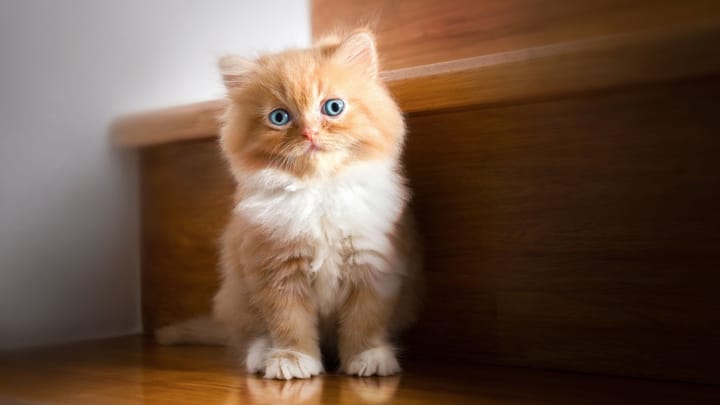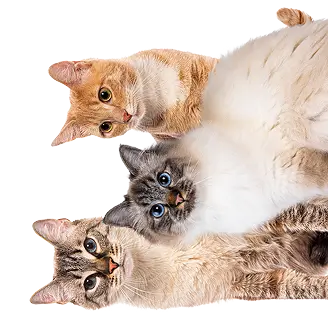Persian


The Persian is one of the most well-known and beloved long-haired cat breeds. With its luxurious appearance and regal temperament, it has captured the hearts of cat lovers for over 300 years. The breed's distinctive features are the result of carefully controlled breeding to achieve its iconic look. Persians rely heavily on human care and attention, both as a breed and on an individual level, requiring special daily care to thrive.
|
Life expectancy |
The Persian has a life expectancy of between 12 and 15 years |
|
Temperament |
|
|
Adult size |
Female
Between 12 and 14 in
Male
Between 12 and 14 in
|
|
Adult weight |
Female
Between 7 and 9 lb
Male
Between 7 and 11 lb
|
|
Coat colour
No colour restrictions. All colours and patterns are possible. However, according to some feline associations, certain coat colours have their own names or are their own specific breed. |
Black Brown White Red Cream Blue |
|
Type of coat
Long |
Long |
|
Eye colour
Depends on the colour of the coat. |
Blue
Green
Yellow
Brown
|
|
Purchase price |
The Persian costs between £250 and £700 |
The Persian cat’s coat is a defining feature, with colours ranging from solid to tortoiseshell, tabby, and smoke. The Persian Colourpoint, which carries the Siamese gene, is known as the Himalayan in some regions. The "shell" coat, where colour is only at the tip of the hair, can be a "silver shell" or Chinchilla. Chinchilla Persians, with their emerald green eyes and less flat nose, are considered a breed in their own right, available in "silver" or "golden" varieties. Breeding Chinchillas together can result in a clearer coat. The Persian Cameo, with a "red silver shaded" coat, is recognised as a breed in the US.
More details about the Persian
Persian: Origins and history
The Persian cat's exact origins are unclear, but it's believed to have descended from Turkish Angoras, with roots in Iran or Turkey (ancient Persia). In the 17th century, long-haired cats from Persia were actually Angoras, not Persians. In the 19th century, British breeders crossed long-haired cats with British Shorthairs to create a more rounded cat with long fur, resulting in the Persian breed. Though breed standards have remained largely the same, selective breeding has intensified traits like a rounder head, smaller ears, and a flatter nose, particularly in the U.S. The "peke-face" variety, created in 1930, has led to more respiratory and ocular issues, sparking ongoing debate between English and American breeders.
Physical characteristics of the Persian
The Persian cat is easily recognised for its distinctive physique. Stocky and large, with strong bones and powerful musculature, its body forms a rounded square from the side. The legs are short, straight, and strong, while the tail is short and fluffy, in proportion to the body. Its coat is the longest of all long-haired cats, up to 8 inches, with a thick undercoat and a collar extending to the belly. The head is round and large, with a dome-shaped skull, strong cheekbones, jaw, and chin, and a flat nose. Persians come in two types: the traditional "doll-face" with a rounder profile, and the more recent "peke-face" with a flatter appearance.
Persian: Characteristics
Persian: Behaviour
Training a Persian
While they are intelligent, Persians are often independent and can be a bit more stubborn compared to other breeds. If you want to train your Persian, focus on positive reinforcement, such as treats or praise, and conduct short, gentle sessions. They can learn basic commands or litter box training, but be prepared for them to engage on their own terms!
Breed compatibility Persian
Persian: Purchase price
A Persian cat can cost between £250 and £700, depending on factors such as sex, age at adoption, parentage, and adherence to breed standards. Generally, females are slightly more expensive than males. Monthly upkeep is typically around £45, though it can be higher. The main costs are grooming, followed by high-quality food and veterinary fees, which together make up a significant portion of the budget.
Persian: Shedding
Heavy !
With their thick, luxurious coat, Persian cats do shed, and it's inevitable that you'll find fur on your furniture. Regular grooming helps manage shedding, but some stray hairs will still make their way onto your sofa.
Persian: Grooming
The Persian's grooming routine is quite demanding. Their fine fur and thick undercoat tangle easily, and mats can form if not properly maintained. Daily brushing helps prevent these issues. Occasionally, a shampoo followed by drying with a hairdryer may be needed to remove dead hair, restore volume, and maintain a glossy coat. Trimming their fur can also help, either to enhance their round shape, simplify maintenance, or address specific hair concerns.
In addition to their coat, Persians require special care for their eyes and ears. Their large eyes tend to tear more than normal, so they should be wiped daily to prevent infections or irritation in the folds of skin around the eyes and nose. Their small ears also accumulate wax, so cleaning with a dry cloth or ear cleaning solution can help prevent infections. A vet can advise on the appropriate frequency for these tasks.
Persian: Health
The lifespan of Persian cats can vary significantly due to their delicate nature, but on average, they live between 12 and 15 years. With proper care, a healthy diet, and regular veterinary check-ups, some Persians can even live longer. It's important to manage their health proactively, as they may be prone to certain hereditary conditions that can impact their longevity.
Persian cats are sensitive to extreme weather conditions, preferring neither cold, wet, nor hot environments. Their thick coat easily tangles or retains heat, and their short nose struggles with both cold air and the smog of intense heat. Their large eyes are also prone to irritation from wind and dryness. For their comfort and health, Persians are best suited to an indoor environment with a controlled climate.
Due to their physique, genetics, and more sedentary nature, Persians are prone to obesity. It’s important to carefully monitor their diet to ensure they maintain a healthy weight.
Persian cats, like all breeds, are susceptible to certain health issues. It’s important to be aware of the following conditions:
- Polycystic Kidney Disease (PKD): genetic disorder affecting the kidneys, often leading to kidney failure around 7 years of age. Screening tests are available, and some breeders are working to eliminate this from their lines
- Hypertrophic Cardiomyopathy: heart condition that can lead to heart failure
- Progressive Retinal Atrophy (PRA): hereditary eye disease that causes rapid vision loss, often starting early in life. Ongoing research aims to develop a genetic test
- Corneal Sequestra: condition affecting the cornea, common in Persians
- Respiratory Problems: due to their brachycephalic (flat) facial structure, Persians may experience breathing difficulties
- Bladder Issues: conditions like cystitis and bladder stones are common in the breed
Regular veterinary check-ups, a balanced diet, and a proper grooming routine can help maintain your Persian’s health. Always consult with your vet for advice on managing breed-specific conditions.
Biologically, female Persians often experience their first estrus (heat) later than females of other breeds. They also tend to have smaller litters, and births can be more complicated due to the larger size of the kittens' skulls. As a result, there is a higher likelihood of requiring a Caesarean section, and the breed has a higher rate of perinatal mortality. Authorised crosses for breeding are with the Exotic Shorthair, a short-haired variation of the Persian.
Do you want a Persian cat ?
Frequently asked questions
What is the personality of a Persian cat?
The Persian cat is very affectionate and enjoys a playtime session, but because of their physical characteristics, they can't exercise intensively. Some might find the Persian cat to be a little bit distant, but it's just a cat breed which needs time to adapt to change. This cat breed doesn't particularly like dogs or cat but gets on well with other children.
Do Persian cats like to cuddle?
Persian cats are known for being very affectionate and gentle, so yes they do love cuddles. This cat breed loves to be close to its owner and curl into a ball onto its owner's laps.
Can Persian cats be left alone?
Persian cats are laid back and probably won't be bothered if their owner leaves them on their own for a few hours. But like any other cats, make sure you don't leave your cat for too long.
How long does a Persian cat live?
The life expectancy of a Persian cat is between 12 to 15 years.
How much does a Persian cat cost?
A Persian cat costs between £250 and £700 but this price depends on the sex, age, parents' pedigree, compliance with breed standards, etc.





